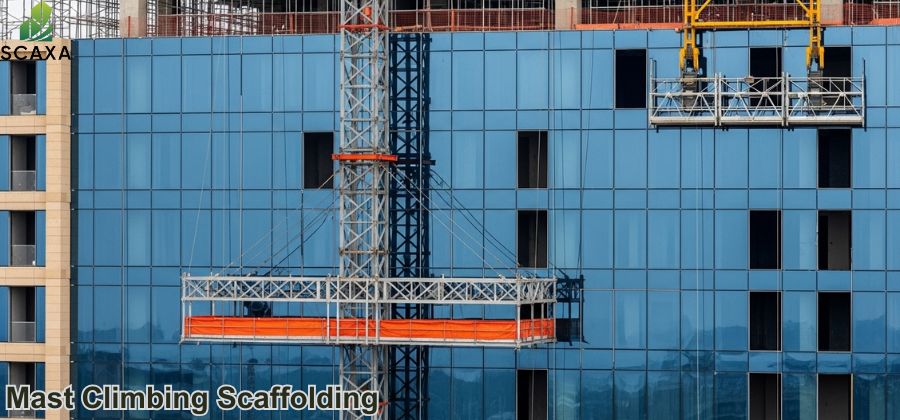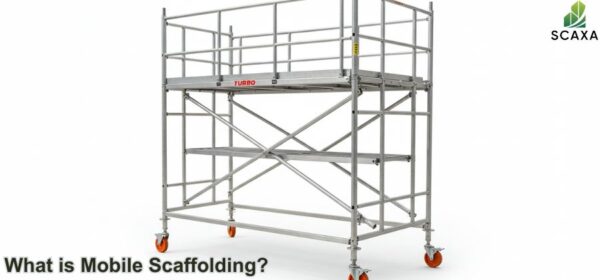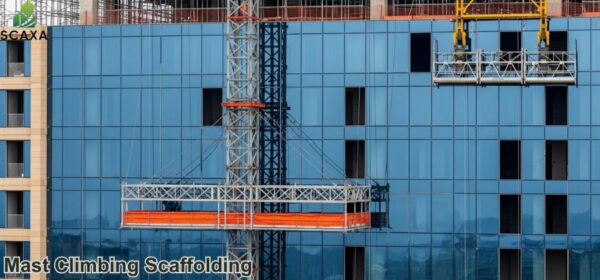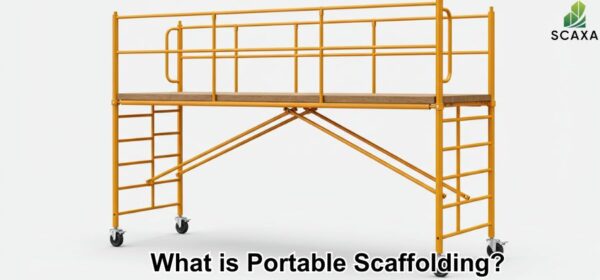Mast climbing scaffolding is a modern, power-driven platform scaffolding that travels vertically up and down tall buildings. It can support far heavier loads than traditional scaffolding and safely carry both materials and workers to the required working level. Double-stacked Platforms, light-duty and heavy-duty mast climbers are some of the common types of mast climbing scaffolds.
Mast climbing Scaffolding is commonly used for tall buildings because it provides easy access to tight spots and enables workers to reach the required height. It’s very easy to set up and disassemble, which makes it an attractive option for contractors. It is also flexible and highly portable. Most importantly, it comes with built-in guardrails, so it provides enhanced safety and fall protection to the workers.
Table of Contents
What Is Mast Climbing Scaffolding?
Mast-climbing scaffolding is a motorized scaffolding with a wide platform that utilizes a vertical mast or tower to go up and down a building. This modern scaffolding can support heavy loads and pump up materials and personnel to the necessary height for work. It is ideal for the high-rise buildings the UAE is known for, so you will often see it around construction sites in Dubai.
The common types of mast climbing scaffolding are light-duty and heavy-duty scaffolding, and double-stacked platforms. Light-duty scaffolding is used to handle lighter loads, whereas heavy-duty scaffolding can support heavier loads. The former can support up to 3 tonnes, whereas the latter can carry loads of up to 10 tonnes. A Double-Stacked platform is the most efficient type of mast climbing scaffolds. It features two vertically stacked platforms mounted on a mast. These platforms can be jointly or separately operated.
The mast climbing scaffolding is valued by the contractors because of its flexibility and portability. It provides precise access to tight spots and improves productivity. The guardrails and wide platforms also reduce the risk of falls. Overall, mast climbing scaffolds are an advanced scaffolding structure with plenty of benefits and uses in the construction industry.
How much is the Rental of Mast Climbing Scaffolding?
The rental cost of mast climbing scaffolding can range between $500 and $1200 (AED 1836- AED 4407) per unit daily. The cost for each rental will vary depending on platform size, project height requirement, load capacity, location, and the additional services (like transportation, installation, etc.) availed. Light-duty mast climbers tend to be lower in cost, while double-stacked mast climbers are expensive.
Many companies in Dubai offer scaffolding rental services. They will also transport and set up the mast climbers for a small cost, according to the policies and regulations set by OSHA. This will save your time by preventing unnecessary delays and save money in the long run by helping you avoid fines and legal issues.
What are the Benefits of Mast Climbing Scaffolding?
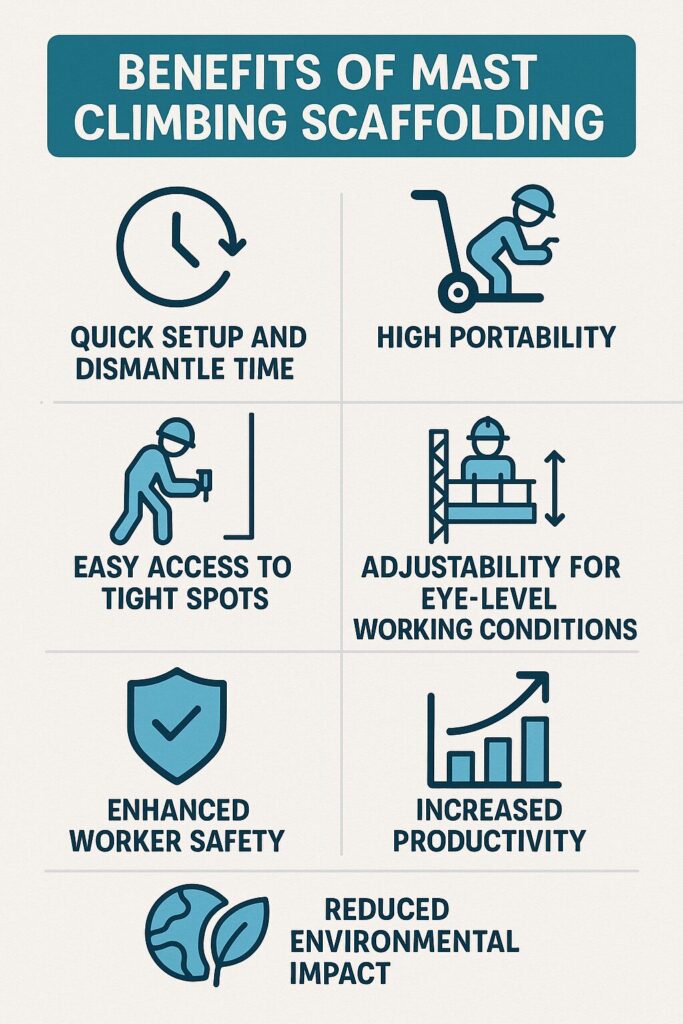
There are seven major benefits of mast climbing scaffolding:
1. Quick Setup and Dismantle Time
Mast climbing scaffolding systems can be efficiently assembled and disassembled as they are made of fewer components and modular designs. A trained professional can install and dismantle this system within hours. Then, the components can be moved to the new site for use. This reduces labour cost and improves work productivity, which makes it quite useful in time-sensitive projects.
2. High Portability
Mast climbing scaffolding is easy to move, as it is often mounted on wheels. This allows the workers to relocate it to a new location without completely dismantling it. The modular sections can also be easily dismantled to move the scaffolding in case wheeling is not possible. High portability makes this scaffolding a perfect choice for projects that require access from different locations.
Traditional scaffolding is often too bulky, so it cannot be erected in tight spaces. Mast Climbing Scaffolding can be adjusted to fit in limited spaces and reach narrow spots. The vertical motor-powered platform enables the workers to position themselves exactly where needed to access a specific spot without risking their safety. This enhances accessibility and improves efficiency.
4. Adjustability for Eye-Level Working Conditions
The adjustable platform allows the workers to raise or lower it to reach eye-level working conditions. This allows the workers to access their tools and work surface with comfort and precision without straining their hands and muscles. Maintaining eye-level access to the work surface is necessary when workers are bricklaying or plastering, so mast climbing scaffolds are great for such tasks.
Mast Climbing Scaffolds feature built-in guardrails, anti-tilt mechanisms, and overload sensors. The enclosed space on the platform minimizes the risk of falls and provides a safe working environment for the workers. These features also keep the platform stable and allow this scaffolding to maintain structural integrity even at greater heights.
The quick installation and dismantling, as well as the high portability and platform adjustability, improve overall work efficiency and productivity. Plus, workers can focus on their work without worrying about slipping and falling. They can easily adjust their height level without complex scaffolding adjustments. This streamlines workflow and saves time that would have been spent installing or repositioning the scaffolding.
7. Reduced Environmental Impact
Mast climbers consist of fewer materials and components in comparison to traditional scaffolding, which reduces the need for resource-intensive manufacturing and frequent replacements. Their efficient transport and limited site footprint also lower emissions and waste. Additionally, since projects finish faster with this scaffolding, there is a reduced environmental impact as there is less energy use and noise pollution.
Overall, mast climber scaffolding is an adjustable and portable scaffold that can be used to access different spots in a fast-paced construction project. It also minimizes fall risk and can be used to gain access to tight spots in narrow spaces.
What are the disadvantages of Mast Climbing Scaffolding?
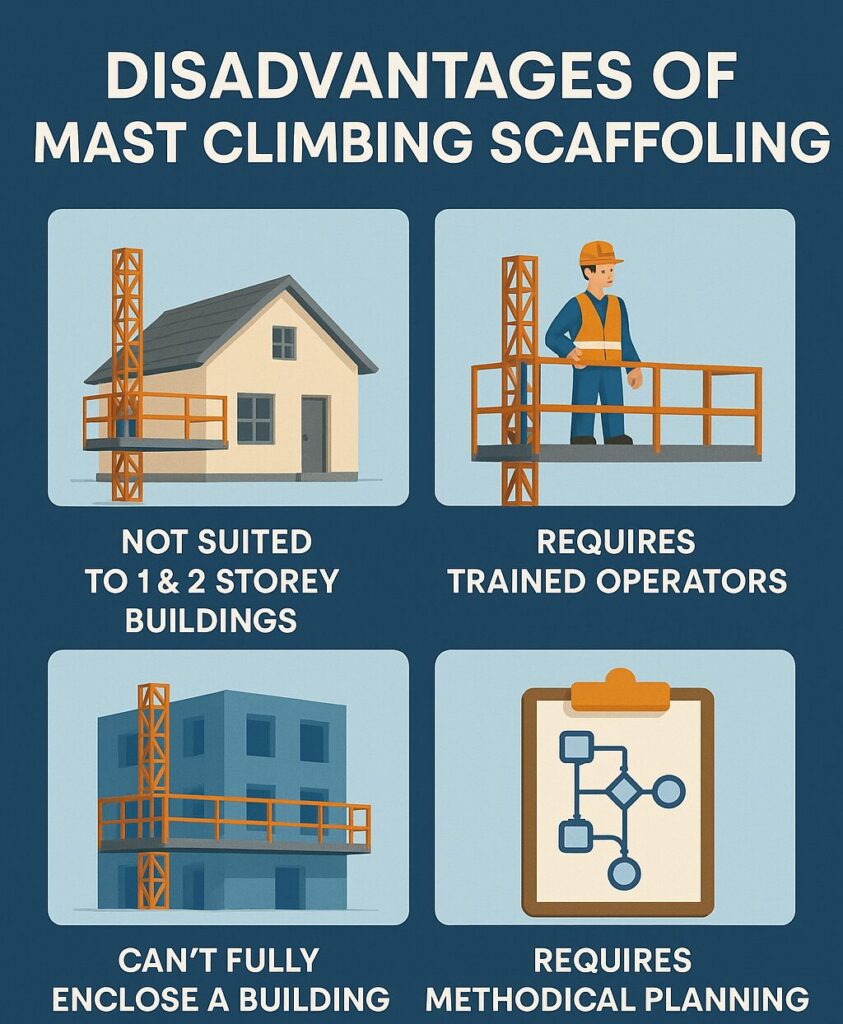
Mast climbing scaffolding does have some disadvantages and limitations. For example, it requires trained operators to manage the platforms, it is not suitable for short structures, and it cannot fully enclose a building.
1. Not Suited to 1 & 2 Storey Buildings
Mast Climbing Scaffolding is not suitable for single or double-storey buildings. That’s because the installation time, resources used, and logistical requirements outweigh the advantages of mast climbing scaffolding for low-rise buildings. Traditional and simple scaffolding structures are more appropriate for one or two-storey buildings as they are quite inexpensive and require less methodical planning compared to mast climbers.
2. Requires Trained Operators
This scaffolding possesses a motor-powered platform and mechanical components that require trained and certified operators. An average worker lacks the proper understanding to ensure the safe operation and working of mast climbing scaffolding. The need for a skilled and certified workforce to handle this scaffolding can increase operational costs and make it an unfeasible choice for projects running on a strict budget.
3. Can’t Fully Enclose a Building
Mast climbing scaffolding can’t fully enclose a building like a conventional tube and coupler scaffolding. This is why it is not ideal for projects that require full coverage for either tasks, weather protection, or dust containment. Consequently, it is often combined with other scaffolding systems to fully enclose a building. Contractors generally prefer to invest in other modular scaffolding when full coverage is required.
4. Requires Methodical Planning
Installing a mast climber scaffold requires meticulous planning. Anchorage points, power supply, platform size, and location must be considered carefully before it is set up. It must also be properly integrated into the construction site to avoid delays and safety concerns. Most scaffolding can be adapted later, but mast climbers need proper planning according to the project’s needs.
5. Resistance to New Technologies
Some construction teams prefer to invest in traditional scaffolding because they are unfamiliar with mast climbing scaffolding. This usually happens because of a lack of training and fear of mechanical failure. As a result, contractors pass on this scaffolding for the conventional structure. This can be changed by properly training and educating the workers on the functionality, operation, and benefits of mast climbing scaffolds.
What are the uses of Mast Climbing Scaffolding?
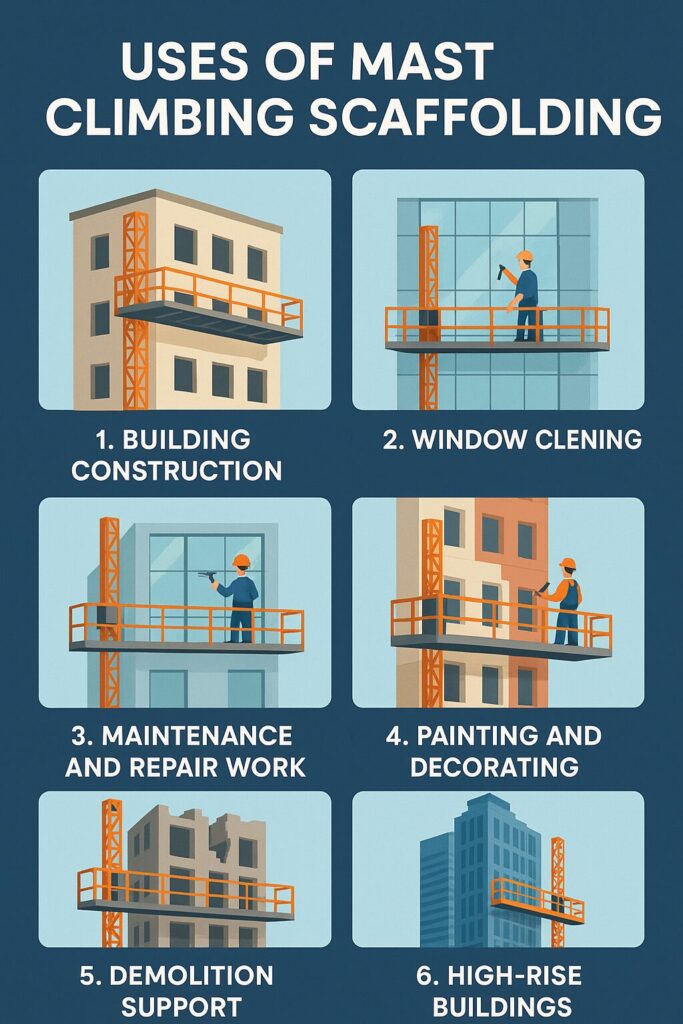
Mast Climbing Scaffolding is used in the construction of high-rise buildings, maintenance work, demolition, window cleaning, and painting tasks. It is popular because of its versatility and vast functionality.
1. Building Construction
Mast climber scaffolds are used in the construction of mid-rise and high-rise buildings. They provide a stable platform for carrying workers and their tools to greater heights. It also protects the workers and tools from falling because it has built-in guardrails and anti-tilt mechanisms. Moreover, its motorized platform takes the workers precisely to the spot required for tasks like bricklaying and concrete repair. All these features make mast climbing scaffolding an amazing modern scaffold structure.
2. Window Cleaning
It is used to clean and repair windows in tall residential and commercial buildings. Mast Climbing scaffolds are a far better choice than suspended platforms because they are more stable and sturdy and reduce the risk of sway caused by winds. Additionally, the secured platforms and the ability to adjust to reach the precise location make the work environment ergonomic and further minimize the risk to the workers. Most cleaning companies prefer to use light-duty mast climber scaffolding for window cleaning.
3. Maintenance and Repair Work
Mast climber scaffolds enable workers to access tall buildings vertically and offer stable platform support, so they are used for repair work and maintenance of high-rise commercial and residential buildings. They are employed to fix concrete cracks, seal leaks, and façade elements. They provide reliable access to hard-to-reach spots and protect the workers from slipping and falling.
4. Painting and Decorating
This scaffolding is perfect for painting and decorative tasks, as it provides precise platform positioning and eye-level access to the work surface. The easy access and accurate positioning allow the laborer to work efficiently, boosting productivity. The mast climber scaffolding height adjustments are also instant, further saving time and energy for the workforce.
5. Demolition Support
Mast climber Scaffoldings are extensively used in controlled demolition projects, as it can carry debris and workers vertically down the buildings. The debris that is tricky to remove is loaded onto its platform and carried smoothly down. Plus, in partial or floor-by-floor demolitions, they provide a sturdy platform for cutting, dismantling, and removing materials.
6. High-Rise Buildings
It is most suitable for high-rise buildings. Traditional scaffolding cannot remain stable at greater heights, making it impractical and dangerous. Mast Climber scaffolding can offer vertical access up to 100 meters and more while maintaining structural integrity and support. It also protects workers who are working at tall structures by providing them with rail support and a balanced platform base.
This is why mast climber scaffolding is used in the construction and maintenance of the high-rise buildings found throughout Dubai. It is also why the maintenance guidelines and procedures issued by the Occupational Safety and Health (OSHA) regarding the working, maintenance, and storage of mast climbers are quite strict.
What are the Safety Requirements of Mast Climbing Scaffolding?
The safety requirements for Mast Climbing Scaffolding in Dubai cover the installation, maintenance, dismantling, and storage protocols. These safety requirements ensure the smooth working of the construction operations and ensure the well-being of the workers and the general public. The safety standards dictate the following requirements:
1. Proper Training for Operators
All workers operating the mast climbers must be properly trained in the system’s mechanical operation and safety protocols. They must also be educated in load capacities, safe exit practices, emergency protocols, and dealing with mechanical malfunctioning. Mast Climber scaffolding has mechanical parts and operation, so ordinary workers cannot be expected to control and operate it. Lack of knowledge or expertise in operating this scaffolding can lead to system malfunction and put workers’ lives in danger.
2. Regular Inspections and Maintenance
Mast climbers must be regularly inspected and maintained to identify damage and malfunctioning components before they can lead to incidents on site. A certified supervisor should be responsible for scheduling technical assessments and timely service of the scaffolding structure’s motors and brakes. There should also be daily visual checks to make sure the cables and anchor system are secured. Proper documentation of the inspection must be done as proof of compliance with the regulations.
It is necessary for mast climber scaffolding to feature guardrails to protect the workers from fall-related injuries. Most mast climbers possess built-in guardrails, but standard guardrails must be installed and secured for the safety of the workers if there are no built-in guardrails. Standard guardrails include top rails, mid rails, and toe boards; they protect workers working at tall structures.
4. Ensuring Platform Stability
The stability of the platform must be ensured every day before use. The platform must be leveled and securely anchored to the structure, as per the manufacturer’s guidelines. Any oversight in this protocol, i.e., improper mast alignment, uneven ground, etc., can lead to excessive swaying and pose a platform tipping hazard. This is why stability checks should be part of daily maintenance and operations.
5. Compliance with Manufacturer’s Load Limits
The mast climber scaffolding can indeed support heavier loads than traditional scaffolding. However, the limit set by manufacturers for this scaffolding must not be exceeded, as this can lead to mechanical strain, platform swaying, and system collapse. This is why it is necessary to distribute the weight evenly on the platform and ensure that the load does not exceed the specified threshold.
6. Proper Positioning and Securing of Mast Climbers
To maintain structural integrity, the mast climber scaffolding must be properly positioned on even, stable ground and anchored securely. Improper anchor placement and failure to follow anchoring guidelines can undermine the stability and balance of the platforms, especially at high elevations. The sites should be assessed meticulously to find the safest setup point for mast climbers.
7. Use of Personal Fall Arrest Systems
Guardrails are usually not enough to protect workers, so personal fall arrest systems are necessary. Workers should wear full-body harnesses connected to solid anchors, especially while working at higher elevations. They should also wear protective vests and helmets to keep themselves safe in case of a fall. The contractors must ensure the smooth integration of personal fall arrest systems at the site.
What are the OSHA Guidelines for Mast Climbing Scaffolding
Construction is at an all-time peak in the UAE, so it is necessary to protect the workforce and craftsmen working on the architectural marvels. For this purpose, the Occupational Safety and Health Administration (OSHA) has set stringent scaffolding requirements for construction projects in the UAE. The protocols and procedures protect the well-being and ensure the safety of the workers. Failure to comply with these rules can lead to legal trouble and unforeseen delays in project completion.
OSHA outlines regular inspection and maintenance procedures for mast climbing scaffolding. Visual checks are mandatory before every use. Plus, only a certified worker can install and disassemble it, and only a trained worker can operate mast climbers. It is also necessary not to overburden it and to follow the proper protocol for the anchoring process. Furthermore, guardrails and fall arrest systems should be utilized to keep the workers safe. Following these protocols will ensure the smooth and long-term working of mast climbing scaffolding.



